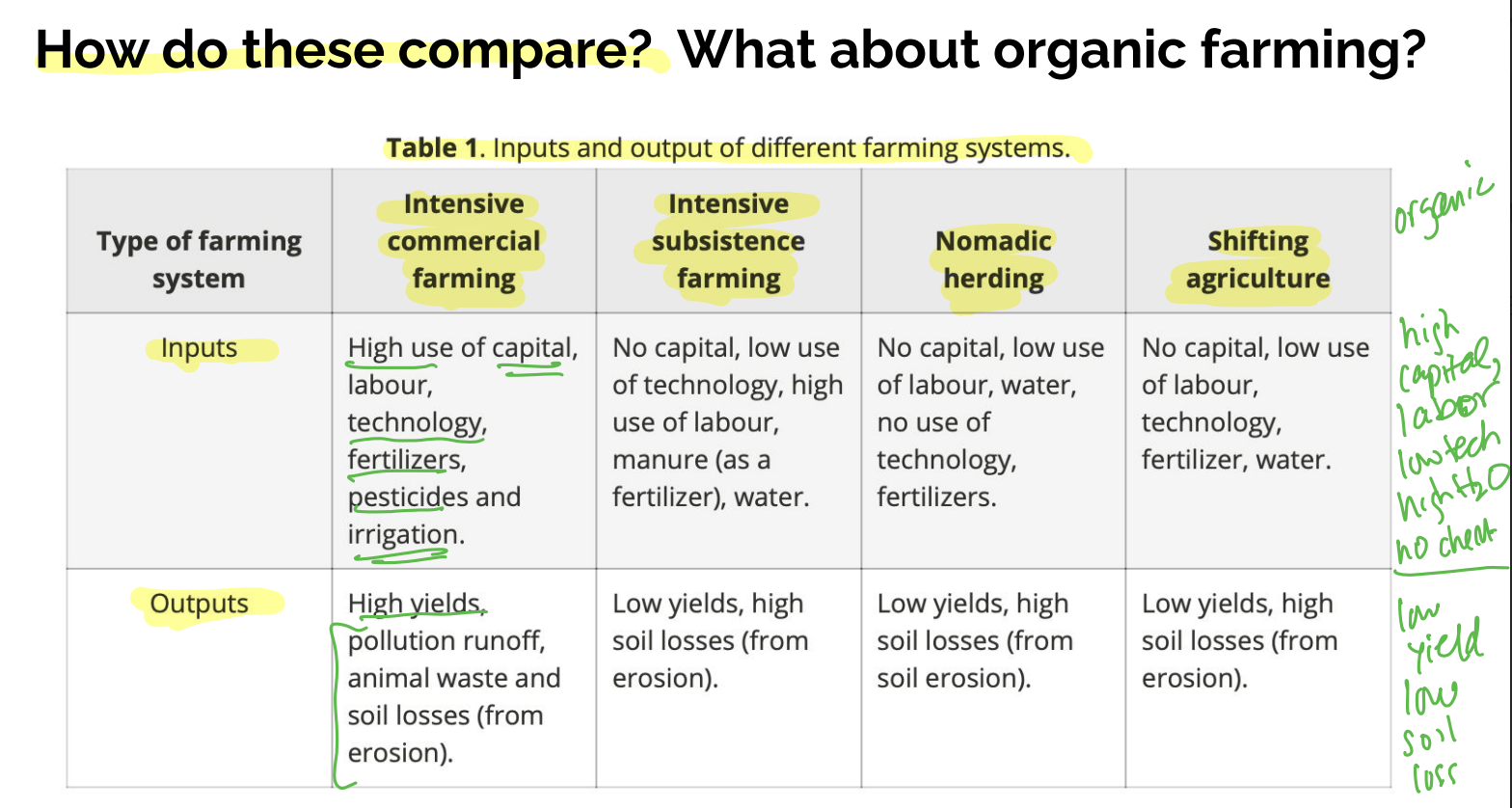5.1-5.2 Terrestrial Food Production Systems
1/17
There's no tags or description
Looks like no tags are added yet.
Name | Mastery | Learn | Test | Matching | Spaced |
|---|
No study sessions yet.
18 Terms
The Green Revolution
1940s
Norman Borlaug
developed use of synthetic fertilizers, pesticides, irrigation, and mechanization to increase crop yields
makes crops look and taste better, grow faster
How does a farmer choose their farming style?
climate (temperature, wet/dry, length of seasons), topography (flat, hilly, etc.), soil conditions (loam, sandy, clay?)
access to vehicles and technology
finances (need to purchase seeds, fertilizers, etc.)
value systems (cultural and/or environmental)
government initiatives (subsidies)
contract farmers — they have contracts with large corporations for seeds and stock which pigeonholes them into only working that company
Arable vs Pastoral
Arable: focused on crops (corn, vegetables)
Pastoral: animal husbandry (cows, chickens, sheep, etc.)
Commercial vs Subsistence
some farms do both
Commercial: high yield/frequent sowing, low cost/high productivity, monoculture (depleting soil), heavy use of GMOs, fertilizers, pesticides, water mechanization/automation
Subsistence: small scale, supports families/communities, meets farmers’ needs/not much surplus, crop variety, dependent on weather, limited use of chemicals
Organic
requires certification of no use of synthetic pesticides or fertilizers
Commercial (crops)
High yield, low cost, frequent sowing of crops
Monoculture of crops (especially cereals)
Use of GMOs, fertilizers, pesticides, herbicides
pollution of soil and water
Impacts of Commercial Crop Production
Pesticides & herbicide: kill non-target species —> reduces BD
many are POPs (like DDT): glycophosphate (Round Up)
Fertilizers lead to nutrient runoff —> eutrophication
nitrates, phosphates
Water abstraction —> competes with other local water needs
Monoculture —> risk of disease in crops —> crop failure + economic losses
ex: Irish Potato Famine
Soil degradation from irrigation & runoff
Loss of habitat & BD
land conversion / wildland —> agricultural lands
Loss of pollinators
needed to spread pollen to fertilize plants so fruits can grow
Glycophosphate
organophosphorus compound made by Monsanto
Targets foliage as opposed to roots
“Roundup ready” crops (GE to withstand Roundup)
WHO classified it as a possible carcinogen
2015: European Food Safety Authority classified it as a possible genotoxic (damaging to genes)
There is some skepticism about its toxicity
carcinogenic?
Commercial Animal Production
Maximum & cheap output
“Battery farming”
animals are inside
Limited space —> no movement —> no energy use —> bigger muscles
Concerns:
Rapid spread of disease in confinement
Ethical concerns
Growth hormone use
Antibiotic use (leads to super bacteria that are resistant to antibiotics)
Waste —> pollution (especially water)
Organic Techniques
physical removal of weeds and pests
hand harvesting
use of IPM
use of beneficial insects or campaign planting to control pests and weeds
ex: ladybugs control aphids
Use of manure, compost, green manure
plants that can be tilled into the soil to improve quality
Crop rotation
alternating what crops are grown in an area
Livestock: organic feed, no drugs
Reasons to support Organic
Health concerns (from use of chemicals or medicine used in commercial farming)
Ethics (especially pertaining to animal production)
Reduced pollution (due to not using synthetic fertilizers and pesticides)
Increased biodiversity
due to multiple crops being grown which will attract pollinators; also, due to no use of pesticides
Increase in income
stimulates economy of smaller farmers (local)
Subsistence Farming
may or may not be organic
meets demand of family/community
3 types
Shifting Cultivation of Crops
Slash and Burn (clear land to grow crops)
When soil is degraded (nutrients are removed), farmers move to a new plot
abandoned plots will eventually recover (succession)
Not sustainable for large populations
Adds CO2 to atmosphere
removes biodiversity + carbon sinks
Low tech and labor input
Low yield (output)
not a lot of crops
Nomadic Herding
Moving with animals to find grazing areas
Cattle, goats, sheep
Low input & output
Outputs = meat, milk, hides
Intensive Subsistence Farming
Intensive = more output than shifting of
Stay in one place (always farming the same land)
Families farm a plot to produce enough for them
Use some traditional farming methods (like terracing)
Use manure to fertilize (maybe some pesticides)
Common in Asia
Intensive vs Extensive Farming
Intensive: high input + output over a small area
Extensive: lots of land — lower output due to small plot
Comparisons
